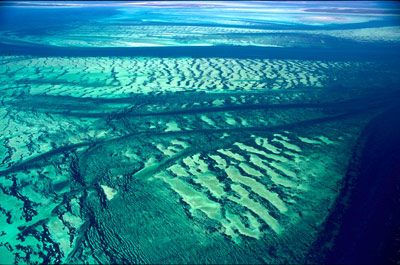Criterion ix (formerly Criterion ii)
Ongoing processes and evolution
Outstanding examples representing significant on-going ecological and biological processes in the evolution and development of terrestrial, fresh water, coastal and marine ecosystems and communities of plants and animals
Shark Bay provides outstanding examples of processes of biological and geomorphic evolution. These include evolution of Shark Bay’s hydrologic system; the hypersaline environment of Hamelin Pool; and biological processes of ongoing speciation, succession and creation of refugia. Shark Bay has:
- steep salinity gradients due to development of banks and sills such as Faure Sill
- three zones of differing salinity levels – oceanic, metahaline and hypersaline
- three distinct biotic zones caused by salinity gradients
- Hamelin Pool, a landlocked marine basin forming a reversed estuary containing hypersaline waters
- restricted communities of marine organisms that have developed physiological adaptations to tolerate hypersaline conditions including the bivalve Fragum erugatum
- vast, rare and scientifically important deposits of Fragum erugatum shells; coquina; ooid shoals; lithified sediments; broad supratidal flats with evolution of subsurface evaporitic deposits; and meromictic blue ponds
- modification of the physical environment caused by vast seagrass meadows as they build banks and sills and influence water currents
- carbonate deposits and sediments – Wooramel Seagrass Bank
- Holocene deposits adjacent to Hamelin Pool and L’haridon Bight; and evidence of ooid formation, submarine lithification and micritisation
- great genetic variability in marine species – pink snapper, venerid clams
- stromatolites and benthic microbial communities
- high species diversity and high density of bivalves
- seagrass-based ecosystems – nutrient cycling, food chain, nursery grounds, habitat variety, and creation of steady-state hydrological conditions
- the largest seagrass meadows in the world
- highly species-rich assemblage of seagrasses
- isolation of fauna habitats on islands and peninsulas
- isolated populations of rufous hare-wallaby and banded hare-wallaby demonstrating evolutionary processes
- transition zone between temperate and tropical marine ecological provinces and resulting high species diversity – 323 fish spp; 218 bivalve spp; 80 coral spp
- transition zone between the Southwestern Botanical Province dominated by Eucalyptus species and the Eremean Province dominated by Acacia species including:
– 145 known plant species at their northern limit in Shark Bay
– 39 known plant species at their southern limit in Shark Bay
– 28 known endemic vascular plant species
– vegetation of the southern Nanga and Tamala areas containing a pronounced overlap between botanical provinces - the northern end of range for numerous southern faunal species including known species of reptiles, amphibians and birds
- coastal end of range for arid-interior species, including numerous known species of frogs, geckos, skinks and monitors
- examples of ‘gigantism’ in tree heath vegetation south of the Freycinet Estuary; and the diversity of plant and animal species including an estimated 35% of Australia’s total bird species.

